"Traditional cars use about 70 bicycles, and electric vehicles are expected to use more than 300 bicycles."
"Chip shortage storm, standing at the center."
"When the price of the core is rising, the price of some models will increase by more than dozens of times, and dozens of yuan will become thousands of yuan."
It is the MCU.
01
MCU's Growth History
MCU (Microcontroller Unit), microcontroller, it has a well-known name: single-chip microcomputer. What makes it "really fragrant" is that,Moving a basic computer system onto a chip,It contains a reduced version of CPU, RAM, ROM, I/O, counter, serial port, etc. Although its performance is definitely not as good as a computer in a broad sense, it has low power consumption, programmable and flexible, so it is widely used in consumer electronics, medical, It has a very wide range of applications in industry, communications, and automobiles.
It was born in1971,designed by Intel the world's first microprocessor—— The 4-bit chip numbered 4004 has more than 2,000 transistors integrated on this chip. At the same time, Intel also designed 4001, 4002, and 4003 chips, which are RAM, ROM, and registers.
When these four major products were launched, Intel wrote in the advertisement that "announcing a new era of integrated circuits: microcomputers are condensed on a single chip." At that time, minicomputers and mainframes were dominated by 8-bit and 16-bit processors, so Intel quickly launched the 8-bit microprocessor 8008 in 1972 to quickly win the market, and since then opened the era of single-chip microcomputers.
In 1976, Intel introduced the world's first programmable microcomputer controller 8748,It integrates 8-bit CPU, 8-bit parallel I/O, 8-bit counter, RAM, ROM, etc., which can meet the needs of general industrial control and instrumentation. Represented by 8748, it has opened the exploration of single-chip microcomputers in the industrial field.
In the 1980s, 8-bit single-chip microcomputers became more and more mature, with increased RAM and ROM capacity, generally equipped with serial interfaces, multi-level interrupt processing systems, and multiple 16-bit counters. In 1983,Intel launches MCS-96 series 16-bit high-performance microcontroller,The number of internally integrated transistors reaches 120,000 pieces.
Since the 1990s,The single-chip microcomputer has entered the stage of contention among a hundred schools of thought, and it has fully bloomed in terms of performance, speed, reliability, and integration. According to the number of bits in the bus or data registers, it gradually develops from the initial 4 bits,With 8-bit, 16-bit, 32-bit and 64-bit microcontrollers.
At present, the instruction set of MCU is mainly divided into CISC and RISC, and the core architecture is mainly based on ARM Cortex, Intel 8051 and RISC-V.
MCUs with different bits, cores and instruction sets have different market shares. According to the 2020 China General Microcontroller (MCU) Market Briefing,32-bit MCU products accounted for 55% of the market, followed by 8-bit products at 43%, 4-bit products at 2%, and 16-bit products at 1%, It can be seen that the mainstream products in the market are 32-bit and 8-bit MCUs, and the market space for 16-bit MCU products is severely squeezed.
CISC instruction set products accounted for 24% of the market, RISC instruction set products accounted for 76%, and were the mainstream products in the market; Intel 8051 core products accounted for 22%, followed by ARM Cortex-M0 products, accounting for 20% , ARM Cortex-M3 products accounted for 14%, ARM Cortex-M4 products accounted for 12%, ARM Cortex-M0+ products accounted for 5%, ARM Cortex-M23 products accounted for 1%, RISC-V core products The proportion is 1%, and the other proportion is 24%. in summary,ARM Cortex series cores account for up to 52%, which is the mainstream of the market.
Over the past 20 years, the MCU market has been facing a predicament of sharp price declines, but in the past 5 years, the rate of decline in its average selling price (ASP) has slowed down. After experiencing the downturn in the auto industry, the weak global economy, and the crisis of the epidemic,MCU market recovers from 2020. According to IC Insights data, in 2020, MCU shipments will increase by 8%, and in 2021, total MCU shipments will increase to 12%, hitting a record high of 30.9 billion units, while ASP will also rise by 10%, the highest increase in 25 years. 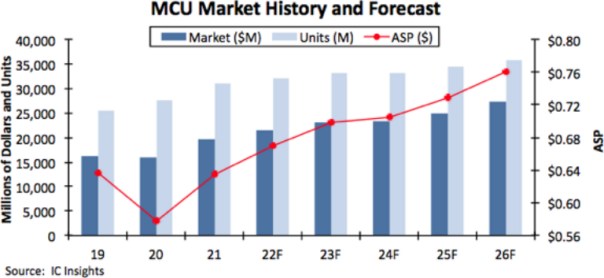
IC Insights predicts that in the next five years, MCU shipments will reach 35.8 billion units, with total sales reaching $27.2 billion. Among them, the sales of 32-bit MCUs are expected to reach 20 billion US dollars, with a compound annual growth rate of 9.4%, 16-bit MCUs are expected to reach 4.7 billion US dollars, and 4-bit MCUs are not expected to grow.
02
Car MCU crazy overtaking
Automotive electronics is the largest application scenario of MCU. IC Insights expects global MCU sales to grow 10% to a record $21.5 billion in 2022, with automotive MCU growth outpacing most other end markets.
More than 40% of MCU sales come from automotive electronics,And it is expected that in the next five years, the sales of automotive MCUs will grow at a compound annual growth rate of 7.7%,more than general-purpose MCU(7.3%)。
At present, automotive MCUs are mainly 8-bit, 16-bit, and 32-bit, and MCUs with different numbers of bits work differently.
Specifically:
The 8-bit MCU is mainly used for relatively basic control functions, such as the control of seats, air conditioners, fans, windows, and door control modules.
The 16-bit MCU is mainly used for the lower body, such as engine, electronic brake, suspension system and other power and transmission systems.
The 32-bit MCU is suitable for automotive intelligence, and is mainly used in high-end intelligent and safe application scenarios such as cockpit entertainment, ADAS, and body control. 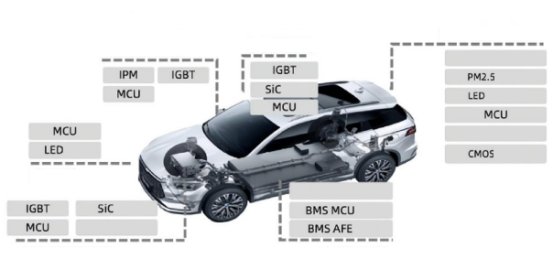
At this stage,8-bit MCUs are growing in performance and memory capacity,plus its own cost-effectiveness ,Can replace some 16-bit MCU applications,also backward compatible with 4-bit MCU applications. The 32-bit MCU will play an increasingly important role in the entire automotive E/E architecture,it can manage scattered middle and low-end ECU units, and the number of usage will continue to increase.
The above situation puts the 16-bit MCU in an awkward position, and it is not enough to be high enough to be low enough. However, it still has a place to play in some application scenarios, such as some key applications of the power transmission system.
The intelligentization of automobiles has greatly boosted the demand for 32-bit MCUs. According to the McClean report, in 2021,more than three-quarters of automotive MCU sales come from 32-bit MCUs,it is expected to reach about $5.83 billion; 16-bit MCU revenue is about $1.34 billion; 8-bit MCU revenue is about $441 million.
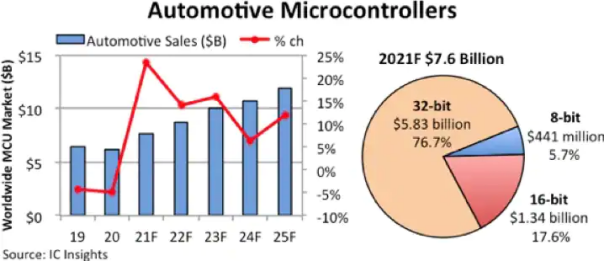
From the application level, infotainment is the application scenario with the highest year-on-year growth in automotive MCU sales. In 2021, it will increase by 59% compared with 2020, and the revenue of other scenarios will increase by 20%.
Now all electronic control of automobiles needs to use ECU (Electronic Control Unit), and MCU is the core control chip of ECU. Each ECU has at least one MCU. Therefore, the transformation and upgrading of smart electrification at this stage has led to an increase in the demand for MCU single-vehicle usage. .
According to data from the Research Department of the Automobile Marketing Expert Committee of the China Marketing Society, the average number of ECUs in a single vehicle for ordinary traditional fuel vehicles is 70. Luxury traditional fuel vehicles have higher performance requirements for seats, central control entertainment, body stability and safety. The number of ECUs can reach 150, and the average number of ECUs in a single vehicle can reach 300 due to the new hardware and software requirements for autonomous driving and assisted driving in smart cars. Correspondingly,the number of MCU bicycles will also reach more than 300.
Automakers' strong demand for MCUs will be particularly evident in 2021 due to the lack of cores due to the epidemic. That year, many car companies had to temporarily shut down some production lines due to the lack of cores,but sales of automotive MCUs soared 23 percent to $7.6 billion, a record high. Most automotive chips are produced on 8-inch wafers. Some manufacturers, such as TI, are shifting to 12-inch lines. IDM will also outsource part of their production capacity. Among them, MCU is the mainstay, and about 70% of the production capacity is undertaken by TSMC. However, the automotive business itself accounts for a very small proportion of TSMC, and TSMC focuses on the advanced process technology field of consumer electronics, so the automotive MCU market is particularly scarce.
The shortage led by automotive chips has also ushered in a wave of production expansion for the entire semiconductor industry. Major OEMs and IDM factories are actively expanding production,But the emphasis varies.
TSMC's Kumamoto plant is expected to be put into operation by the end of 2024. In addition to the 22/28nm process, 12 and 16nm processes will be further provided, and the Nanjing plant will expand its production to 28nm, with a monthly production capacity of 40,000 pieces;
SMIC plans to expand production by at least 45,000 8-inch wafers in 2021,at least 10,000 12-inch wafers, and build a 12-inch production line with a monthly production capacity of 120,000 wafers in Lingang, focusing on 28nm and above nodes;
Hua Hong expects to accelerate the expansion of 12-inch production capacity to 94,500 pieces in 2022;
Renesas announced that it will take a stake in TSMC's Kumamoto Plant,in tentions to expand outsourcing, and the goal is to increase the supply of automotive MCUs by 50% by 2023, and the production capacity of high-end MCUs is expected to increase by 50% compared with the end of 2021, and the production capacity of low-end MCUs will increase by about 70%; STMicroelectronics will invest $1.4 billion in production expansion in 2022,It is planned to double the production capacity of European factories by 2025, mainly to increase 12-inch production capacity. For 8-inch production capacity, STMicroelectronics will selectively upgrade products that do not require 12-inch technology;
Texas Instruments will add 4 new factories,It is expected that the first factory will be put into operation in 2025, and the third and fourth factories will be built between 2026 and 2030;
ON Semiconductor increased capital investment to 12%,Mainly used for 12-inch wafer capacity expansion.
IC insights has an interesting data,The ASP of all 32-bit MCUs declined at a CAGR of -4.4% between 2015 and 2020, but rose by about 13% in 2021 to around $0.72.
Reflected in the spot market, the price fluctuation of automotive MCU is more obvious: the NXP 32-bit MCU FS32K144HAT0MLH with a normal price of 22 yuan rushed up to 550 yuan,the amplitude is more than 20 times, which is one of the most scarce automotive chips at that time; Infineon’s 32-bit automotive MCU SAK-TC277TP-64F200N DC once rose to 4,500 yuan, an increase of nearly 100 times. The SAK-TC275T-64F200N DC of the same series also skyrocketed to more than 2,000 yuan.
On the other side, the originally hot consumer electronics began to cool down, weak demand, and the acceleration of domestic substitution,as a result, the price of general-purpose and consumer MCUs has fallen, and the prices of some ST chip models such as F0/F1/F3 series have come close to the normal price, and even the prices of some MCUs have fallen below the agency price. However, automotive MCUs such as Renesas, NXP, Infineon, and ST are still in a state of relative shortage, for example, the quotation of ST high-performance 32-bit MCU STM32H743VIT6 climbed to 600 yuan at the end of last year,two years ago, its quotation was only 48 yuan, an increase of more than 10 times; the market price of Infineon Automotive MCU SAK-TC237LP-32F200N AC was around 1,200 yuan in October last year, and the quotation in December was as high as 3,800 yuan,even the quotation on the third-party website exceeds 5,000 yuan。
These automotive MCUs, which have become popular models and Internet celebrities, also declare the status of MCUs in automotive electronics.
03
The market is huge, but domestic production is small
The MCU competition landscape is like the entire semiconductor competition environment, where overseas giants occupy a dominant position. In 2021, the top five MCU manufacturers are NXP, Microchip, Renesas, ST, Infineon,the sales of these top five MCU manufacturers accounted for 82.1% of the total global sales,in 2016, it was 72.2%, and the scale of leading enterprises has grown stronger in recent years.
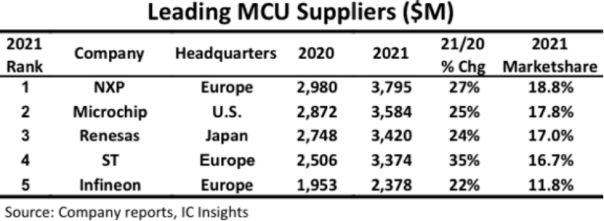
The following are some domestic MCU companies:
The head effect of the automotive MCU market is even more significant. Compared with consumer and industrial MCUs, the certification threshold for automotive MCUs is high and the certification cycle is long. The certification system includes ISO26262 standard certification, AEC-Q001-004 and IATF16949 standard certification, AEC-Q100/ Q104 standard certification, in which ISO26262 divides automotive functional safety into four levels from ASIL-A to D,f or example, scenarios such as chassis have the highest safety requirements and require ASIL-D level certification, and there are very few chip manufacturers that can meet the requirements.
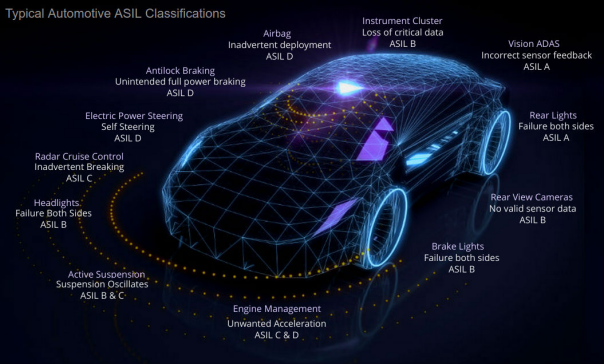
According to Strategy Analysis data, the global and domestic automotive MCU markets are mainly occupied by NXP, Renesas, Infineon, Texas Instruments, and Microchip, with a market share as high as 85%. my country's MCU manufacturers are mainly concentrated in the low-end field,although the 32-bit MCU is still monopolized by overseas giants, some domestic companies have made progress.
The 32-bit MCUs of Jiefa Technology, BYD Semiconductor, NationalChip Technology, Chipsea Technology, Xinwangwei, Qipuwei, Saitengwei and Lingou Chuangxin have all passed AEC-Q100 certification. According to the statistics of Guorong Securities, most domestic mass production companies can pass the AEC-Q100 certification, but they are mainly concentrated in Garde1/3. However, there are very few domestic manufacturers that can pass the ISO26262 certification, and most of them are concentrated in the ASIL-B level.
04
Conclusion
The rapid development of smart electric vehicles has attracted a group of major consumer-grade chip manufacturers to join in. For example, Nvidia, Qualcomm, and Intel have made breakthroughs in smart cockpit and autonomous driving chips, reducing the living space of established automotive chip manufacturers. The development of automotive MCU has changed from focusing on self-development and performance improvement to all-round competition,while striving to reduce costs, we must also maintain technological advantages.
As the automotive E/E architecture moves from distributed to domain control, and finally to central integration, more and more low-end and mid-range chips with simple functions will be replaced, and high-end chips with high performance and high computing power will become future automotive chips focus of competition,t he MCU as the main control role is relatively less affected by the reduction in the number of ECUs in the future. For example, the ECU controlled by the Tesla chassis contains 3-4 MCUs, but some basic MCUs with simple functions will be integrated. Overall, the market and domestic alternatives for automotive MCUs in the next few years will undoubtedly be vast.



























